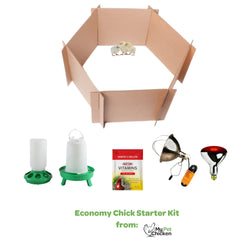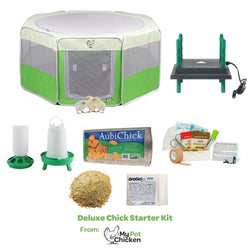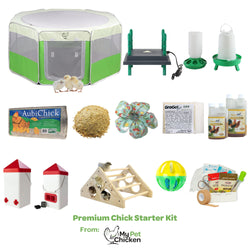How do you get such beautiful photos of your chickens?
Back to blog
Yes, chickens can be difficult to photograph, can't they? Much like little kids, they're not really interested in cooperating with you to get you a good shot, and they certainly don't want to hold still!
There are some techniques our My Pet Chicken photographers use that you won't really be able to reproduce at home. For instance, many of our photos are studio shots, where the chickens are inside under carefully arranged lighting conditions and with high-end equipment to make for especially good professional photos. And we photograph many of our birds at competitive Poultry Shows, where the birds are judged according to breed standards. Not only are those birds world-class quality, oftentimes having been carefully bred for decades to achieve breed standards, but they have also been primped and preened by their owners to show them off for the judges. That's not something you're going to be able to replicate at home! But there are still plenty of tips we can share for you to get good shots of your own birds.
First, of course, you will want to make sure you are using a good camera. You don't need to spend thousands on an expensive top-of-the-line camera. Even a reasonably priced point-and-shoot can take excellent photos, especially if there is little to no delay on your shutter. In other words, if possible, you'll want to choose a camera where you'll be able to press the shutter release and have the photo taken instantly. A delay of only a second can mean your chickens may be in an entirely different pose, or with their tails to you. Many point-and-shoot type cameras have "sports" or "action" settings that can capture fast action. That's a great feature to have for getting shots of chickens who usually don't just pose for you in that perfect position. If you already have a camera, check to see if yours has a sports or action setting that might make taking sharp photos easier when your chickens are moving around.

"I don't intend to hold still for you!"
Second, an abundance of bright, warm light can also help reduce any problems you may have with unclear shots, because the shutter speed can be very fast when the light is bright (it takes less time for the camera to gather enough light for a good image when it is bright!). If you're not in a studio setting, bright morning or evening light (because it is angled and less harsh at those times) is often best. Make sure you are not taking photos from the wrong side of the light, though. Ideally, the light should be behind you or to the side. If the light is coming from behind your chicken, your photo may end up being a bright, over-exposed background and a shadowy silhouette of your chicken. If that's what you're going for, then great! But if not, make sure to have the light coming from somewhere else, or have the light hitting the chicken in a way that shows off the gloss of the feathers.

"I'm pretty even when I don't pose."
Third, pay attention to what is behind your chicken in the frame of your photo. You may be taking photos of your beautiful birds from a green, manicured lawn... but that may not be what you see in your shot. For instance, you may also see your neighbor's trash cans, or an ugly, paint-peeling wall. You also want to avoid distractions in the background, like part of someone's foot, the end of a garden hose and so on. Photos looking down at your chickens may be nice, occasionally, but you will probably find you get better shots if you crouch down a little and take some shots from "chicken height." Getting a great photo means paying attention to everything in the frame of your shot, so close-ups can be very effective.

"Is there a treat hidden in the camera lens?"
Finally--and most importantly, take LOTS of photos. This is a good "secret" for photographers of any subject matter. If you take 100 photos of your chickens one morning, you are likely to come back with at least one or two good ones! In the era of digital cameras, this is easy to do, too! To get a good panoply of shots, one trick is to try scattering some treats like sunflower seeds, pumpkin seeds, meal worms, kibble or the like. Once your birds have all rushed to eat, find a good composition, paying attention to where the light is and what is in the background. Then, just take your photos! If your birds are too intent on the food, you can try making a noise that momentarily catches their attention. When they pause eating to look in the direction of the sound, start snapping!
There are some techniques our My Pet Chicken photographers use that you won't really be able to reproduce at home. For instance, many of our photos are studio shots, where the chickens are inside under carefully arranged lighting conditions and with high-end equipment to make for especially good professional photos. And we photograph many of our birds at competitive Poultry Shows, where the birds are judged according to breed standards. Not only are those birds world-class quality, oftentimes having been carefully bred for decades to achieve breed standards, but they have also been primped and preened by their owners to show them off for the judges. That's not something you're going to be able to replicate at home! But there are still plenty of tips we can share for you to get good shots of your own birds.
First, of course, you will want to make sure you are using a good camera. You don't need to spend thousands on an expensive top-of-the-line camera. Even a reasonably priced point-and-shoot can take excellent photos, especially if there is little to no delay on your shutter. In other words, if possible, you'll want to choose a camera where you'll be able to press the shutter release and have the photo taken instantly. A delay of only a second can mean your chickens may be in an entirely different pose, or with their tails to you. Many point-and-shoot type cameras have "sports" or "action" settings that can capture fast action. That's a great feature to have for getting shots of chickens who usually don't just pose for you in that perfect position. If you already have a camera, check to see if yours has a sports or action setting that might make taking sharp photos easier when your chickens are moving around.

"I don't intend to hold still for you!"
Second, an abundance of bright, warm light can also help reduce any problems you may have with unclear shots, because the shutter speed can be very fast when the light is bright (it takes less time for the camera to gather enough light for a good image when it is bright!). If you're not in a studio setting, bright morning or evening light (because it is angled and less harsh at those times) is often best. Make sure you are not taking photos from the wrong side of the light, though. Ideally, the light should be behind you or to the side. If the light is coming from behind your chicken, your photo may end up being a bright, over-exposed background and a shadowy silhouette of your chicken. If that's what you're going for, then great! But if not, make sure to have the light coming from somewhere else, or have the light hitting the chicken in a way that shows off the gloss of the feathers.

"I'm pretty even when I don't pose."
Third, pay attention to what is behind your chicken in the frame of your photo. You may be taking photos of your beautiful birds from a green, manicured lawn... but that may not be what you see in your shot. For instance, you may also see your neighbor's trash cans, or an ugly, paint-peeling wall. You also want to avoid distractions in the background, like part of someone's foot, the end of a garden hose and so on. Photos looking down at your chickens may be nice, occasionally, but you will probably find you get better shots if you crouch down a little and take some shots from "chicken height." Getting a great photo means paying attention to everything in the frame of your shot, so close-ups can be very effective.

"Is there a treat hidden in the camera lens?"
Finally--and most importantly, take LOTS of photos. This is a good "secret" for photographers of any subject matter. If you take 100 photos of your chickens one morning, you are likely to come back with at least one or two good ones! In the era of digital cameras, this is easy to do, too! To get a good panoply of shots, one trick is to try scattering some treats like sunflower seeds, pumpkin seeds, meal worms, kibble or the like. Once your birds have all rushed to eat, find a good composition, paying attention to where the light is and what is in the background. Then, just take your photos! If your birds are too intent on the food, you can try making a noise that momentarily catches their attention. When they pause eating to look in the direction of the sound, start snapping!



